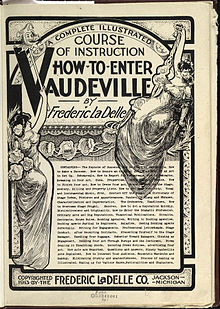
 In the last half of the 19th century and the first half of the 20th, vaudeville ruled American and Canadian stages. Vaudeville performances usually consisted of a variety of different, unrelated acts grouped together on one bill. Typically, this included comedians, musicians, dancers, magicians, actors, acrobats, and, in the more risqué houses, burlesque. Vaudeville was an extension of the travelling medicine shows, sideshows, circuses, burlesque shows and dime museums that had entertained working class audiences around the country in the early half of the 19th century. It basically took the crowd-pleasing elements of these travelling shows and combined them under one roof while, in most cases, toning down the bawdy material, in an attempt to draw in middle class audiences of all ages.
In the last half of the 19th century and the first half of the 20th, vaudeville ruled American and Canadian stages. Vaudeville performances usually consisted of a variety of different, unrelated acts grouped together on one bill. Typically, this included comedians, musicians, dancers, magicians, actors, acrobats, and, in the more risqué houses, burlesque. Vaudeville was an extension of the travelling medicine shows, sideshows, circuses, burlesque shows and dime museums that had entertained working class audiences around the country in the early half of the 19th century. It basically took the crowd-pleasing elements of these travelling shows and combined them under one roof while, in most cases, toning down the bawdy material, in an attempt to draw in middle class audiences of all ages.
Ironically, despite the attempt to tone down more risqué material, it was in vaudeville that we first started to see America’s fascination with the female form. Many historians believe that it was during the early days of vaudeville that the female body became a “sexual spectacle” in itself. For the first time in American culture the sexualized female form began to permeate popular culture: in the shops, the restaurants, the grocery store and in the newspaper. And as the image of the sexualized female form became more popular with the general public, vaudeville producers began including more female acts where the women would wear revealing attire and tight gowns. Even an innocent sister act would sell better than a comparable male act and many female vaudeville performers were then encouraged to focus less on talent and more on their figure. Eventually, audiences would be surprised when a female possessed actual talent in addition to being good looking.
Read More…


 Arts
Arts Comedy
Comedy Event Tips
Event Tips Film
Film Food & Drink
Food & Drink Good Causes
Good Causes Music
Music News
News Radio
Radio Roller Derby
Roller Derby